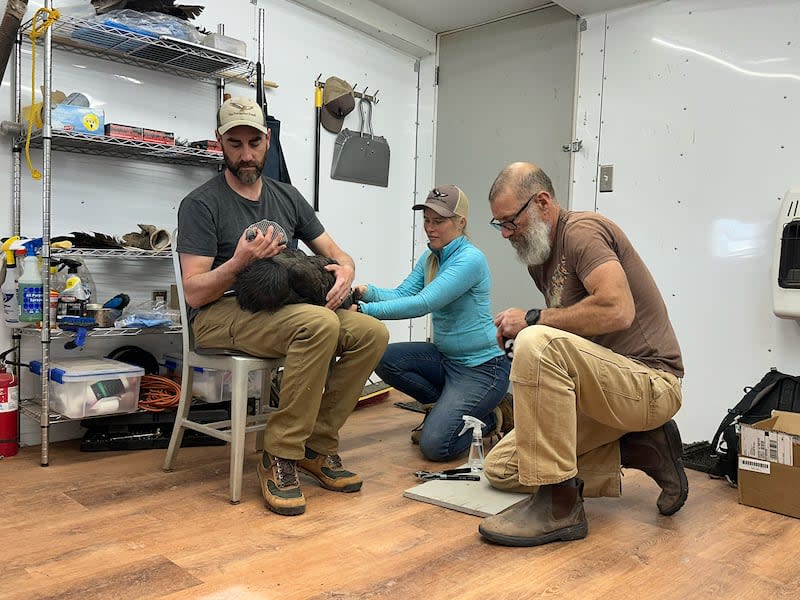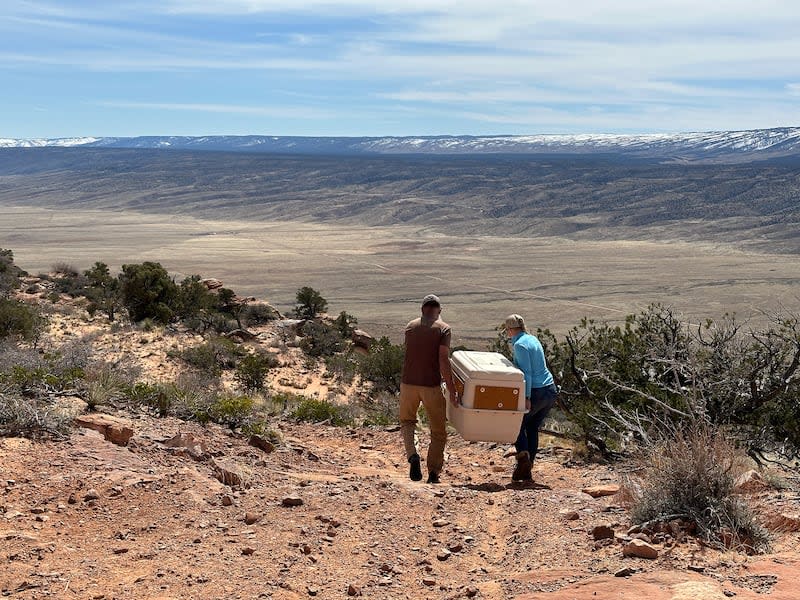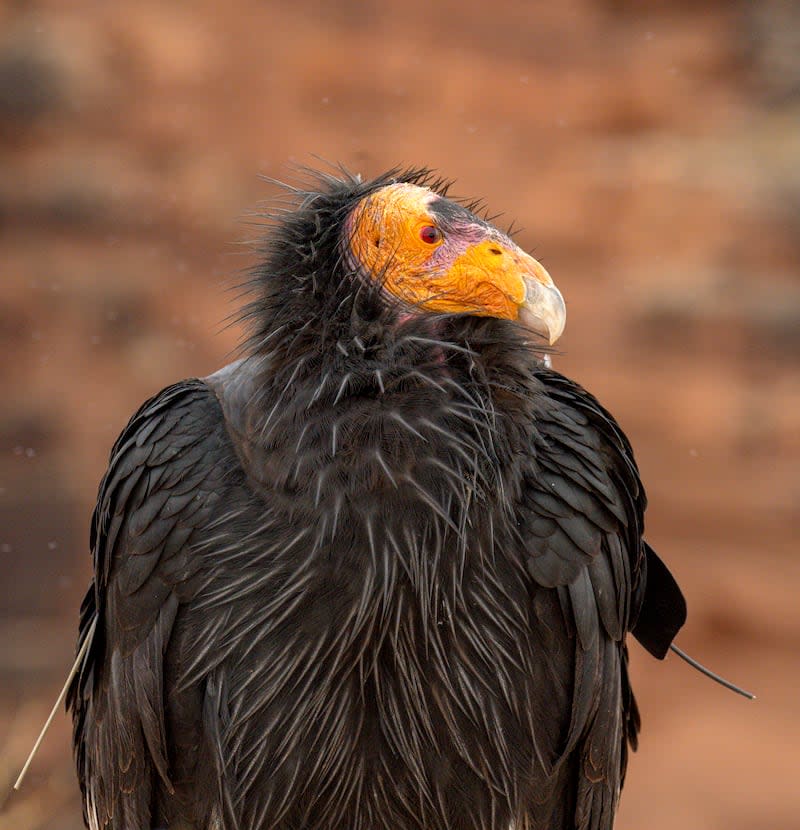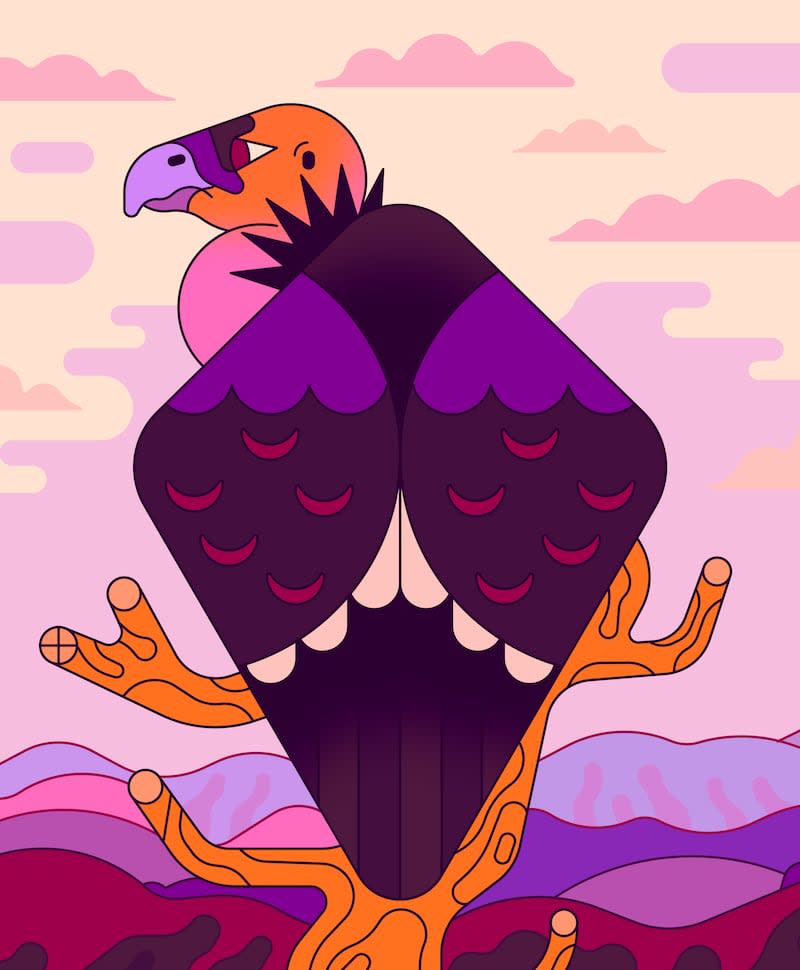Explorers and settlers couldn’t agree on whether they beheld beauty or beast. In 1806, on the banks of the Columbia River, William Clark jotted in his journal that the California condor is “a handsom bird,” an observation later contradicted by an account in the Sacramento Daily Union describing “a huge monster” that terrified the residents of a small Nevada outpost. In the same era, Scientific American called them “as graceful and majestic as any bird in the world,” only to be disputed by Field & Stream, which described the California condor as evil looking, “like a cross between an executioner and an undertaker.”
Bald and hunchbacked, with a head that changes from peach to orange to yellow depending on its mood, and tufts of black plumage that poof out from the base of its wrinkly neck like a fur coat on an elderly woman, Gymnogyps californianus is a bird of contradictions. A symbol of both death and resurgence. The sight of one wheeling overhead signals another animal’s passing — and the vulture’s next meal — but as a species, it has survived multiple brushes with mortality.
In 1982, just 22 remained in the wild. Today, there are about 560. Curiously, the culprit of the condor’s precipitous decline in the last century — and what keeps its numbers dangerously low now — measures less than two inches long and weighs less than 10 grams. The lead bullet, the very tool those European settlers used to colonize the West, has placed condors in near-constant mortal peril. While predators, vehicle collisions, electrocution from power lines and forest fires also kill condors, none are as detrimental as lead poisoning, which kills half the population annually. Because they constantly feed on carrion, and because they congregate in groups — they’re as socially attached to each other as we are — a single lead-laden carcass can poison multiple birds at once. “It only takes one little lead fragment that’s as big as a couple of grains of sand,” says Myra Finkelstein, an environmental toxicologist at University of California, Santa Cruz. “That has enough lead to kill a condor.”
To keep the species from disappearing forever, fewer lead bullets will need to litter the West, and scientists will need to continue the project that brought the birds back from the brink. In the 1980s, researchers captured all 22 birds, held them in a breeding facility, and raised their chicks before releasing them back into the wild. As one of the first animals listed under the Endangered Species Act, the condor’s recovery was deemed a testament to federal wildlife protections.
Today, those efforts continue, led by conservation biologists as vehement about the dangers of lead as they are committed to reintroducing more raptors into the wild. Some may seem as contradictory as the birds themselves.
“I can introduce myself as someone who spent 23 years trying to recover the condor, or I can introduce myself as a lifelong hunter,” says Chris Parish, president and CEO of the nonpartisan nonprofit The Peregrine Fund. His choice depends on the audience. Parish, who’s goateed and wears a cowboy hat, grew up hunting in a ranching community in the San Joaquin Valley, just outside of Bakersfield. The region is California’s biggest source of oil production. It’s also the heart of condor country.
In 1950, at the onset of the Korean War, locals revolted against plans for a condor sanctuary in lieu of oil development. And when the Endangered Species Act was passed in 1973, people thought it “threatened the way we lived,” Parish recalls — namely, tightening regulations on hunting and land development. In a 1994 article in Outdoor Life about the legislation’s renewal, the Sportsmen’s Coalition for Common Sense Amendments to the ESA suggested that “radical animal rights activists are using the law to advance their agenda.”
The debate had split into a conservationist-versus-hunter dichotomy. Yet, “some of the most successful and renowned hunters were the forefathers of ornithology,” Parish says, citing European explorers known for their scientific discoveries. Plus, he adds, anyone who shoots an animal with a lead bullet and leaves the cadaver — be it cattle, horses, coyotes or ground squirrels — is exposing wildlife to lead.
Because they constantly feed on carrion, and because they congregate in groups — they’re as socially attached to each other as we are — a single lead-laden carcass can poison multiple birds at once.
Parish now spends a good chunk of his time shooting copper and lead bullets into plastic barrels filled with water bags and ballistic gel. It’s a key part of the Non-Lead Partnership he helped kick-start in 2018 to educate shooters about what happens when a lead bullet enters a carcass. Hundreds of tiny shards spray into the flesh, making it virtually impossible for a scavenger to avoid. Copper bullets, on the other hand, retain their shape, splaying open like a flower without shattering.

Finkelstein, the environmental toxicologist, has co-authored studies on lead poisoning in birds over the past two decades. Her team’s recent work shows it wouldn’t take much to tip the scales in the condor’s favor. Just a 1 percent reduction in lead poisoning would equate to releasing two to three captive-reared birds. That’s significant when condors only produce one chick every other year and don’t breed until six to eight years old, making natural reproduction painfully slow.
The shooting demonstration has helped nearly 90 percent of the region’s hunters, ranchers and other shooters decide to switch to non-lead ammunition or to remove carcasses shot with lead. It doesn’t just help condors. Bald eagles, golden eagles and other animals — including humans — are likewise affected by lead poisoning. “Where we fail is not in the science,” Parish says. “We fail in talking about what the implications from our findings are.”
On a clear-skied morning in March, biologist Tim Hauck met me on Navajo Bridge in Marble Canyon, Arizona, to watch condors soar and swoop above the turquoise Colorado River.
These rust-colored canyons are a magnet for people who are running from something or looking for something, Hauck recalls Parish telling him. An ornithology graduate from Rochester, New York, Hauck wasn’t sure what he was looking for when he joined the condor crew 20 years ago. What he did find was a family, The Peregrine Fund condor-recovery team. They call themselves the Condorks. “The problem with condors is they hook you,” Hauck confesses. His dark beard is now speckled with gray, and his ball cap depicts the endangered bird of prey. “It’s not hard to fall in love with this species.”

Still, it isn’t easy to convince people to stay in remote Marble Canyon, where the closest grocery store is 45 minutes away and you’re forced to be alone with your thoughts. But those who care enough will stick around for decades. Shawn Farry, a veteran conservation biologist who joined us on the bridge that morning, should know. He was around for the first-ever release in 1996. If lead poisoning continues to kill more birds than are born, it’s possible that in the Condorks’ lifetimes, they will never see a completely self-sustained population. But that’s the goal — to work themselves out of a job.
“We know that canyon, don’t we, Shawn,” Hauck said to Farry, peering through binoculars. They remember that canyon like a nightmare.
“The problem with condors is they hook you. It’s not hard to fall in love with this species.”
One year earlier, some of the condors’ tracking devices suddenly went motionless. It could have meant three things: The trackers fell off, the birds were listless from lead poisoning or they had died. The second option seemed most likely. But as more trackers went still, the crew grew worried. So when Hauck and Farry had spotted a single wing sticking out from the canyon cracks, they assumed the worst. An inflatable National Park Service boat scooped them up, and as they drew close to the motionless carcass, they readied a body bag.
But the bird blinked. It was still alive.
They were used to seeing lethargic condors with lead poisoning, but this one was worse. Hauck cursed in anger as he carried the sick condor back to the boat, cradling her in his arms, wishing she were dead instead of suffering. They sent her to Liberty Wildlife hospital in Phoenix, hoping for a miracle. She died a day later.
It wasn’t until they collected almost two dozen sick birds that they found an answer. HPAI, the avian influenza that has spread from poultry to cattle and other animals, had snuck up on condors like a plague. The biologists spent 12-hour days rappelling down cliffs wearing PPE to rescue as many sick birds as they could. In just three weeks, they lost a fifth of the population — a setback equivalent to almost 20 years of conservation efforts. “It was like the biggest monster that you’ve ever seen, just rose up out of the depths, out of nowhere,” Hauck recalls. “There was nothing you can do.” A spectator sport, one USDA virologist brutally put it. Unlike the lead threat, they had no control over this one. Eventually, the deaths stopped, and condors became the first animal to be vaccinated for avian flu. But it threatened to wipe out decades of conservation progress in a blip.
A condor doesn’t just fly; it glides. An adult condor’s wingspan can stretch as wide as 9.5 feet, and it can weigh up to 26 pounds. That’s a lot of body weight to haul through the air, and yet, they manage to effortlessly soar up to 200 miles in a single day. Masters of aerodynamics, they stretch their wings out straight to gain elevation and curve them inward to swoop down. The edges of their wings span out into a feathery fringe, making a soft, fluttering noise you can hear when they fly overhead. Crane your head up toward the sky, and you’ll see the white patch of plumage that spreads along the length of each underwing against the black of its body, and between them, the pink dot of its head.

Today, the raptors reign over an impressively wide terrain, from coastal California to northern Mexico, and from the desert cliffs of Arizona’s backcountry to southern Utah. But thousands of years ago, the condor’s kingdom was much larger. Fossil records indicate that its historic range once extended as far southeast as Florida and as far northwest as British Columbia, at a time when megafauna like sabertooth tigers, mastodons and American cheetahs roamed the land we now call North America.
Scientists aren’t sure how many condors existed back then, but it’s clear that the condor’s demise started around the same time that Europeans arrived. By the time Lewis and Clark set out on their expedition in 1804, the population was already in decline. Cattle carcasses intentionally poisoned in order to kill predators like coyotes, bird hunting and the lucrative egg trade were likely contributors to the condor’s demise. But so was lead poisoning. With the lust for gold, timber and Manifest Destiny came lead ammunition. “The report that the California condor will soon become extinct is not without foundation,” Scientific American reported in 1908. “Unless the needed protection is given, this bird will undoubtedly follow the great auk,” a penguin-like bird in the North Atlantic that went extinct in the mid-1800s.
The raptors reign over an impressively wide terrain, from coastal California to northern Mexico, from Arizona’s backcountry to southern Utah. But thousands of years ago, the condor’s kingdom was much larger.
In California, fish and wildlife biologist Steve Kirkland took me to Bitter Creek National Wildlife Refuge, about two hours north of Los Angeles. When we stopped for gas in Frazier Park, a local in his 70s shared a new nugget of information: In the 1960s, dozens of condors would congregate around the gut piles on a nearby turkey farm. It was the first time Kirkland had ever heard of condors in that area. “We’re learning as we go,” he says. “Nobody who’s alive has ever seen a healthy population.”
In the foothills of the Coast Ranges, Kirkland and I stood on a picnic table with a pair of binoculars overlooking the expanse of the San Joaquin Valley: the farms, the oil rigs and, barely visible, the Sierra Nevada mountains on the horizon. This valley is the condor’s 14,000-acre foraging ground.
Finally, we spotted one — an untagged juvenile sitting just 30 feet away from us. Untagged means wild-born, which is a good sign of natural reproduction. The young bird silently pushed off the ground and beat its wings once, twice, before it was effortlessly riding the wind. The bird climbed higher until it was a mere speck above the mountains, and then, it was gone.
After a chick is born in captivity and raised in a facility like the World Center for Birds of Prey in Boise, Idaho, it’s sent off to Arizona or California for release. Condors, with their razor-sharp beaks and taloned kicks that can bruise, are not easy birds to handle. I found out for myself atop a plateau at Vermillion Cliffs National Monument in Marble Canyon, where I joined the Condorks to prepare adolescent condors for release into the wild. The itinerary was deceptively simple: Capture four condors from a large flight pen — by hand — and transport them to the release pen and lab where the biologists run health checks and bestow each condor with the brand-new wing tags they will wear for life.
Hauck, Farry and fellow biologist Brianna Bode loaded ATVs with empty dog kennels and garbage bags full of frozen calf carcasses — a tasty treat for the condors when they’re done. “You’re going to watch us look like fools for a few minutes while we try to catch condors,” Hauck told me as we approached the flight pen. Inside, Hauck and Farry chased around the raptors as they flocked from one end of the enclosure to the other. They eventually guided four of them into their respective kennels, lifted each kennel onto an ATV, strapped them down securely, and four-wheeled off to the release pen.
There, the crated condors sat in silence awaiting their examinations. But inside, the team of three deftly hurried from one task to the next. Hauck and Farry punched holes into vinyl cattle-ear tags that they fashioned into wing tags. Bode labeled tiny vials for blood samples. Hurried hands affixed each tag with a radio transmitter.

One by one, the birds underwent their checkups. One person wrangled a condor into a firm embrace, stood on the scale, and then took a seat, bird in lap, index finger and thumb gently wrapped around its beak. Another biologist ran physicals and drew blood. Wings pierced and tags affixed, each bird was ushered into the release pen to acclimate to their new habitat. In about a week, all four birds would join the others in the Southwest flock.
Later that evening, at the base of Vermillion Cliffs, more Condorks joined to observe the progress of the birds that had been released a few weeks earlier. The biologists’ shadows stretched long as they peered into their scopes. “I’ve got eyes on 33,” one said into her radio. “Copy that,” Bode replied from the top of the cliff, voice gravelly through the airwaves. If a bird settles in a spot that makes it vulnerable to predators, Bode’s job is to scare it off by any means necessary — yelling, waving arms, sometimes howling like a coyote — in a teaching process biologists call hazing. Another Condork followed 1083 through his scope as the youngling attempted a shoddy landing. “My man!” he exclaimed, cheering him on for a second attempt.
To our right, the canyons turned purple with the sunset. We watched as the birds soared around the cliffs until each found its favorite spot to snuggle in for the night. To the average person, watching floating specks through spotting scopes for hours each evening might seem like a slog. But for as long as lead poisoning remains a threat to their survival, the Condorks’ focus stays fixed. In a few years, the inexperienced fliers will reach mating age and couple with a partner. Hopefully, they breed a wild chick, one that isn’t born in captivity for a change. And soon, the four new birds will join them, wings spread wide above the canyons.
This story appears in the June 2024 issue of Deseret Magazine. Learn more about how to subscribe.
Signup bonus from



